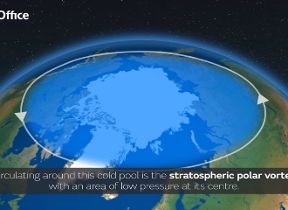Wind flow
The balancing of high and low pressure is what causes wind flow.
How does wind flow around areas of high and low pressure?
The pressure gradient force drives winds from regions of high pressure to regions of low pressure. This force can be demonstrated very simply using a rubber balloon. If you blow up a rubber balloon and then release it without tying a knot the air inside the balloon (which is under high pressure) will rush out until the pressure difference between inside and outside the balloon is equalised. This happens on a much larger scale in the atmosphere and causes wind. The greater the difference between the pressures (the pressure gradient), the stronger the wind.
In reality, wind does not flow directly from areas of high to low pressure as there is a separate force at work - the Coriolis effect. The rotation of the Earth causes wind to experience an apparent force known as the Coriolis force. This force acts at right angles to the pressure gradient force, causing wind to be deflected to the right in the northern hemisphere and to the left in the southern hemisphere. The resulting path of the wind therefore spirals in an outwards direction from areas of high pressure and spirals in an inward direction around areas of low pressure.
In the northern hemisphere this wind spiral flows in an anticlockwise direction around areas of low pressure and in a clockwise direction around areas of high pressure - the opposite is the case in the southern hemisphere as the Coriolis force acts in the opposite direction.





